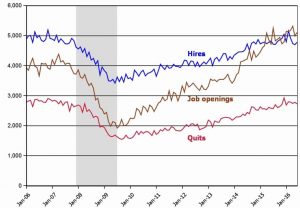Employee Retention in Today’s Market
With 2019 coming to an end, it is no doubt that employee turnover has been an unavoidable challenge this year. With the unemployment rate at an ultimate low, this job market is described as employee-driven. Great for the employees, not so much for employers.
In this blog, we will further examine the specific challenges with employee turnover and a few strategies to help overcome these problems.
Challenges of Employee Retention
There was a time when an employee would work in the same organization all their life. These were the days when the workforce was mainly made up of the Baby Boomer generation. Today we have seen an increasing dominance of Millennials in the workforce. Along with improved technology, a booming economy, and low unemployment rates. All of which have been a factor in trying to increase employee retention.
The Bureau of Labor Statistics states the average worker spends just about 4.4 years in one job. Statistics project this may be reduced by 50% for the youngest aged members of the workforce.
This high turnover rate costs companies heavily. The cost to employers was predicted to hit about $600 billion in 2018 and $680 billion in 2020. This cost includes the cost of rehiring and retraining, among others.
Employers can certainly do without these costs, so adopting strategies to increase employee retention is a must for any business wanting to succeed in this new job market.
Strategies for Employee Retention
Formulating the right approach to increase employee retention begins with an understanding of why employee turnover is high. Even though some of the challenges are inevitable, IE. new technology, unemployment rates, economy…there are strategies that encourage employees to make a job their home. Beginning with the selection process.
The Selection Process
It all starts from the very beginning. Not everyone will be a good fit for your organization. Going beyond their skill requirements, employees need to also fit into a company’s culture. If an employee feels at home in an organization, it is less likely they will leave compared to someone who feels out of place.
By clearly defining the culture of an organization during the selection process will help ensure only those who fit into and enjoy that kind of atmosphere is employed.
Worker Remuneration and Benefits
It’s not ALL about money, but it is still very much important. Offering top talent competitive rates should be the starting point. From there, go a step further by offering other perks and benefits like health care, paid vacations, bonuses, and more.
Workers must feel well appreciated and compensated for their work.
Career Path and Growth
Companies should ask themselves what prospect does an employee have in your organization?
An employee who does not see any opportunity for growth and personal advancement in an organization will likely leave at the slightest chance.
Design systems that facilitate the growth of your workers. Send them to training’s and let them see that by continuing with your organization, their value will continue to rise.
Workplace Culture
Workplace Culture is probably one of the most important factors for today’s workforce. The culture of a workplace should encourage teamwork, community, recognition, and awards for jobs done by individuals and groups, etc. Communication should be accessible and transparent.
Today’s workforce does not thrive well in ultra-formal and bossy environments. The workplace should feel like a family where everyone works towards the same goal, celebrates victories together, and morns losses together too.
If a worker does not wake up in the morning looking forward to get to work, then that worker is just working for a paycheck. So the next bigger paycheck is sure to draw them away.
Pre-empt Moves
Frequently gathering data and analyzing them to understand the mood in the workplace is a good way to identify hints that a person may be unmotivated, restless, or feeling under-appreciated. Shaking up things in the workplace, giving new responsibilities, having an honest conversation with workers, and other little actions can go a long way in preventing a resignation.
Be Prepared
Even with all these strategies, some workers will not stick. As companies try to increase worker retention, they must also stay prepared for the possibility that they may go.
Being prepared for such an outcome reduces the cost of the move on the organization.
Conclusion
More than ever before, today’s workplace must be dynamic, smoothly adjusting to the ever-changing demands of the workforce. Because it worked yesterday doesn’t mean it will work today. If it is working today doesn’t mean it will work tomorrow.
Every workplace must evolve with the times if they want to stand any chance of maintaining a high worker retention rate in today’s market.
Sources:
https://www.forbes.com/sites/jeannemeister/2012/08/14/the-future-of-work-job-hopping-is-the-new-normal-for-millennials/#21be53b513b8
https://workinstitute.com/about-us/news-events/articleid/2259/2018%20retention%20report
https://www.decision-wise.com/employee-retention-is-challenging/
https://www.cio.com/article/2868419/how-to-improve-employee-retention.html

